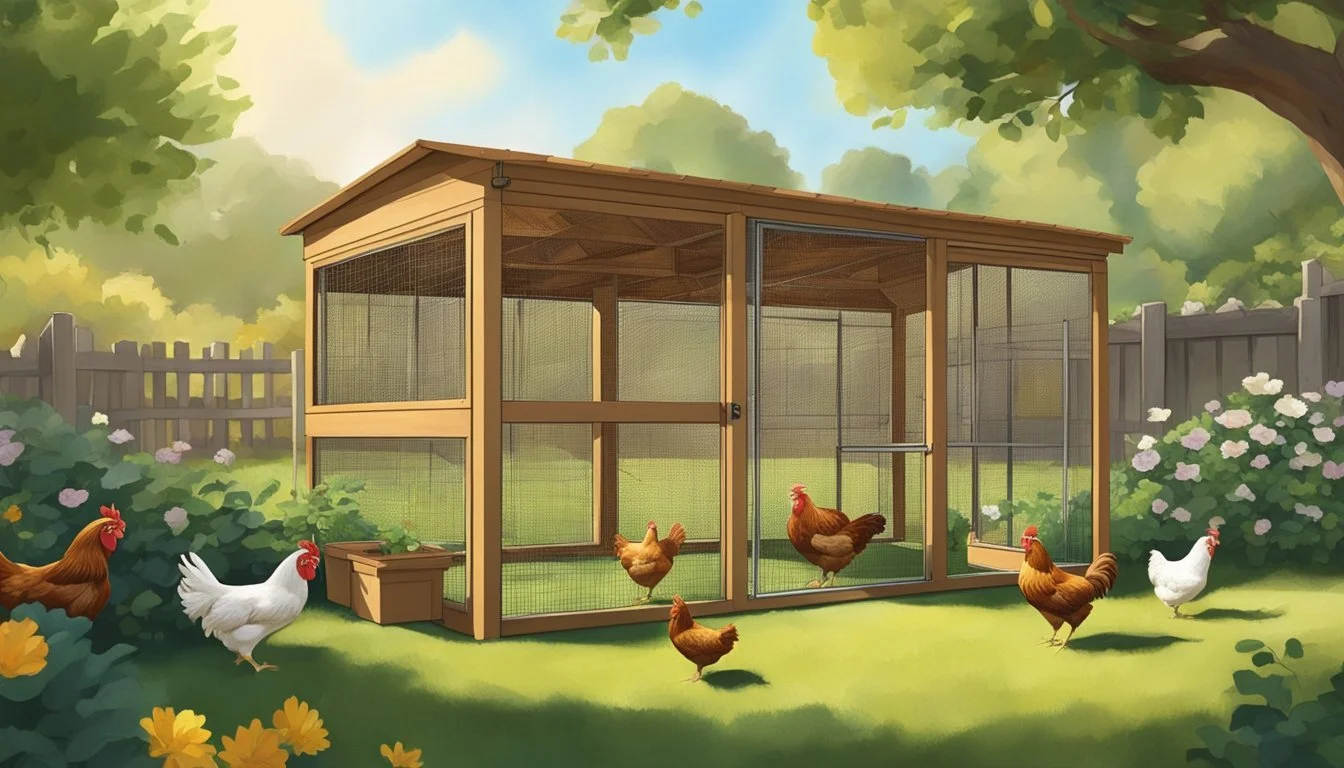Keeping Backyard Chickens in Orange, CA
A Guide to Local Regulations and Best Practices
In Orange, California, the trend of keeping backyard chickens is flourishing among residents who are eager to enjoy fresh eggs and the pleasures of urban agriculture. The city's ordinances provide guidance to ensure the hobby is compatible with local community standards and animal welfare considerations. Enthusiasts within the Orange Municipal Code limits can maintain a flock under certain conditions. Key stipulations include a limit on the number of chickens, prohibition of roosters to avoid noise issues, and a focus on personal use with no sales allowed. Additionally, coops must adhere to specific requirements to foster a healthy environment for the birds and maintain neighborhood aesthetics.
The enthusiasm for backyard hens in California reflects a broader movement towards sustainable living practices, but it also demands awareness and adherence to regulations. For instance, residents of Orange must obtain a permit and possibly demonstrate completion of a training program provided by the University of Florida's Institute of Food and Agricultural Sciences Extension in Orange County. Success in keeping chickens not only hinges on an individual's commitment to the care of the animals but equally on the adherence to these local guidelines designed to benefit the entire community.
While the City of Orange allows the keeping of chickens, there is no one-size-fits-all approach in California, as each municipality has the authority to establish its own set of rules. Those living in homeowners association-regulated neighborhoods may encounter additional layers of restrictions. Hence, potential chicken keepers must thoroughly understand the regulations specific to their situation to ensure that their backyard poultry practices are both legal and considerate of their neighbors.
Legal Considerations for Backyard Chickens in Orange
Prior to establishing a backyard chicken coop, residents of Orange, California must closely adhere to the specific legal framework set forth by local zoning laws and municipal codes.
Understanding Local Zoning Laws
Zoning laws are pivotal in determining if a property is eligible for keeping backyard chickens. In Orange, the residential zones specify the type of animals that can be kept within city limits, and any property owner must first verify that chickens are permissible in their particular zoning area.
Permit and Regulations Overview
Obtaining a permit is a fundamental compliance step for Orange residents interested in backyard chicken keeping. Local ordinances dictate that a permit is required and typically outline conditions such as maximum numbers of chickens allowed, coop specifications, and adherence to nuisance containment.
Specific Orange Municipal Code for Poultry
The Orange Municipal Code governs the keeping of poultry. Owners must conform to Chapter 6 provisions, which articulate the regulations involving the keeping of birds, including chickens. It’s vital that residents consult the latest revision of the municipal code for the most accurate and enforceable standards.
Restrictions on Roosters and Slaughtering
In Orange, local ordinances enforce restrictions on owning roosters and prohibit onsite slaughtering of chickens. These rules are in place to minimize disruption and maintain public health standards. Breeding of chickens and the selling of any eggs or chickens may also be subject to municipal code regulations.
Changes in Local Laws and Regulations
Residents must remain vigilant as local laws and regulations concerning backyard chickens are subject to change. It is incumbent upon all potential and current chicken owners to stay informed of the state and local regulations adjustments. Regular consultation of Orange County and city updates will ensure compliance with the current legal requirements.
Setting Up Your Chicken Coop
Setting up a chicken coop in Orange, California requires thoughtful planning and adherence to local ordinances to ensure the well-being of your backyard chickens. The coop should provide a safe, clean, and comfortable home for chickens while also minimizing any nuisance to neighbors.
Coop Design and Location
When designing a chicken coop, owners must ensure it provides adequate space for the number of chickens allowed. The coop should allow for at least 3-4 square feet per bird. Setback requirements from property lines are typically mandated by local codes, so owners should confirm these regulations to prevent future issues. The coop must be placed in an area with ample sunlight and protection from strong winds.
Safe and Clean Coop Practices
To promote chicken health and prevent disease, maintain a clean environment by regularly removing waste and providing running water for easy cleaning. Local ordinances may also specify coop standards regarding sanitation to deter rodents and other pests. A composting system can manage waste, turning it into a useful resource for gardens.
Coop Maintenance and Composting
Regular maintenance keeps the coop in good condition and safeguards the health of the backyard chickens. Establish a schedule for inspecting and repairing the coop to ensure it remains sturdy and secure. Use appropriate bedding, such as straw or wood shavings, which should be changed regularly to keep the coop clean.
Choosing the Right Chicken Breed
Select a chicken breed suitable for local climate and coop conditions. Australorps, for instance, are an excellent choice for those prioritizing egg production and hardiness. A compatible breed will live comfortably in the coop environment and generate fewer issues related to health and nuisance.
Coop Security Against Predators
Coop security is crucial to protect chickens from predators. The structure should have secure locking mechanisms, reinforced wire mesh, and perimeter defenses to deter intrusion. A solid foundation and overhead cover can provide additional safeguards, making it harder for predators to access the coop.
By adhering to these guidelines, residents of Orange, California can establish a chicken coop that ensures the safety and comfort of their pets and backyard chickens while complying with local ordinances.
Caring for Your Chickens
Responsible backyard chicken care demands understanding the specific needs related to their diet, health, environment, and behavior to ensure their well-being and optimal egg production.
Nutrition and Feeding
Chickens require a balanced diet rich in protein, calcium, and essential nutrients. Adult hens should be provided with a layer feed containing about 16% protein and oyster shell supplements for calcium to support eggshell strength. Chicks, on the other hand, typically start on a higher protein starter feed. Medicated feed can prevent coccidiosis, a common intestinal disease.
Health and Disease Management
Maintaining chicken health involves regular monitoring for signs of illness, parasites, and injury. Common diseases like coccidiosis and avian influenza require quick action to prevent spread. Providing clean living conditions and adequate space helps minimize the risk of disease and supports overall health.
Egg Production and Care
Egg production can be maximized by ensuring hens have a nutritious diet, clean nesting boxes, and a stress-free environment. Collect eggs daily to keep them fresh and minimize the chance of breakage or becoming dirty. Hens need 14-16 hours of light per day to maintain consistent laying patterns.
Handling and Socializing Chickens
Chickens are social animals and often enjoy interactions with their caretakers. Gentle handling from an early age fosters trust and ease in management. Regular interaction allows one to quickly identify any atypical behavior that might indicate stress or health issues.
Water and Environmental Needs
Clean, fresh water should be available at all times. Chickens require running water for drinking, not only to hydrate but also to digest their food properly. Their environment should be safe from predators and have adequate space for foraging. Coops must be cleaned regularly to prevent the build-up of waste and to deter pests.
Local Community and Resources
The inclusion of backyard chickens in Orange, CA taps into a broader movement of urban agriculture and fosters community engagement while requiring access to specialized local suppliers and educational resources. Compliance with local chicken laws is essential to ensure the health and well-being of the poultry as well as the community.
Chickens as Part of Urban Agriculture
Backyard chickens are a growing element of urban agriculture in Orange, offering residents the opportunity to produce their own food, thus contributing to local nutrition and food security. They are integral in teaching the principles of sustainability and responsible food production within the urban setting.
Engaging with Chicken Enthusiast Communities
Residents of Orange can engage with chicken enthusiast communities to exchange knowledge on best practices in raising chickens, disease prevention, and maintaining flock health. These communities often offer support and advice on local chicken laws to ensure responsible upkeep and compliance with municipal codes.
Local Suppliers for Chicken Needs
Local suppliers play a critical role by providing Orange residents with necessary supplies such as feed, coops, and health products. By supporting these businesses, chicken owners can ensure that they are providing their flocks with high-quality nutrition and care.
Key Suppliers in the Area:
Feed & Nutrition: Local farm supply stores
Health & Disease Management: Veterinary clinics specializing in poultry
Coops & Bedding: Local hardware stores and specialized carpenters
Additional Educational Resources
For those in Orange raising chickens, there are educational resources available that cover a range of topics from basic care to advanced health management. These may include local workshops, agricultural extension programs, or online forums.
Resources Available:
Workshops: Orange County Cooperative Extension
Online Communities: BackYard Chickens forum
Neighboring Cities' Poultry Laws
Orange residents should also be aware of nearby cities' poultry laws, as they may be inspired or affected by policies in cities like Long Beach, San Diego, and Los Angeles. Anaheim and Brea, for example, have their own specific regulations that could serve as models or contrasts to those in Orange.
Neighboring Cities' Ordinances at a Glance:
Long Beach & San Diego: Permitting systems and specific restrictions
Los Angeles: Similar to Orange, with an emphasis on distance from residences
Bakersfield: More lenient regulations, reflecting a different urban dynamic
It is important for residents to keep abreast of the laws to ensure they are operating within legal boundaries and to participate effectively in regional discussions on urban agriculture policy.






